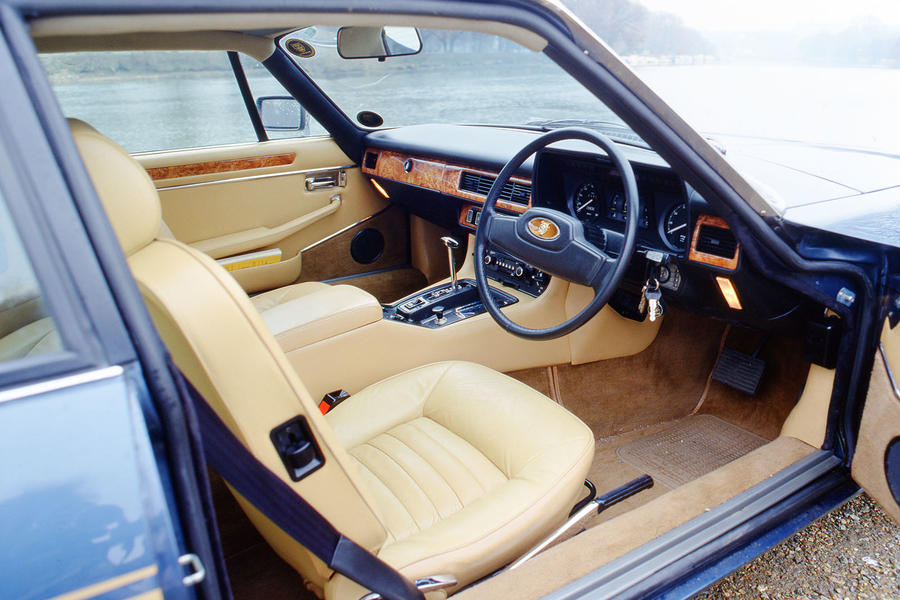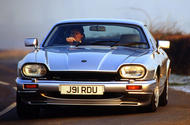The Jaguar XJS launched in 1975
British V12 exotica at its very best, but does that come at a cost?
Only people of a certain age will remember the thrill of watching each new episode of Return of the Saint or The New Avengers way back in the 1970s.
But for many of us motor-mad children, that thrill was not stirred up by Patrick Macnee, Joanna Lumley and Ian Ogilvy acting their hearts out but by the cars that featured in the shows. In Return of the Saint, an updated Simon Templar (Ogilvy replaced Roger Moore, who starred in the original series The Saint) dispensed with his Volvo P1800 and got into a Jaguar XJS, while in The New Avengers, tough-guy Mike Gambit also drove an XJS.
The pleasure in seeing those XJSs, at the time an expensive, exotic and immensely desirable car that one seldom saw on the roads, being given the beans around a bend while in pursuit of a carload of baddies was indescribably exciting.
Indeed, the XJS caused quite a stir when it was launched. That was in 1975, and in those days it was known as the XJ-S, with a hyphen. Of course it was no E-Type (but by then neither was the E-Type). It was rather expensive, for one. And then there were its looks, with those overhangs and bumpers and the flying buttresses. They may have grown on us over time, and its other virtues – as long as you can put up with its disproportionately cramped interior relative to its exterior dimensions – are no longer debatable. Here was a 285bhp, 5.3-litre V12-engined grand tourer with near-silent 153mph performance and a ride to rival that of a hydropneumatic Citroën.

Its life was long and updates were plentiful. In 1981, the V12 engine became the 5.3 HE, for High Efficiency, with clever combustion chambers that swirled the fuel around before ignition and helped increase power to 295bhp. There was an uprated chassis and wider wheels, too. In 1983, the admirable 3.6-litre AJ6 straight-six was introduced. Also in 1983, the XJ-SC cabriolet was launched, to be replaced by the convertible in 1988.
In 1991 the car underwent surgery and emerged rejuvenated if not transformed. It got useful galvanised steel body parts, notably the wings, sills and floorpan. The facelifted cars were sleeker and featured tasteful wraparound rear lights. Also, the model acquired an enlarged, 4.0-litre version of the AJ6 engine and an enlarged 6.0-litre version of the V12. In 1994, the AJ6 engine gained coil-on-plug ignition to become the AJ16. There was even some success with highly modified Tom Walkinshaw versions racing in the European Touring Car Championships.
The end came in 1996, after 21 years of production, when it was replaced by the far more rumbustious XK range. Now, we reckon anyone looking to indulge their 1970s TV fantasies could hook up with a well-restored XJS and they’d still be hugely impressed by its supreme levels of refinement. You won’t need superhero money to buy one at the moment, either, although considering its age and occasional fragility, you may well need nerves of steel if you’re planning to use it often.
What we said then
7 Febraury 1976: “Overall the XJS is a superb car. With very few exceptions, when you compare it with its nearest competitors, it is not only competitively priced, but it’s also a completely sorted car giving the highest levels of satisfaction. Jaguar really has done its development work on this car. We envy anyone in a position to buy one. It’s expensive but a joy to drive.”

An expert’s view
Chris Knowles, KWE: “The biggest problem is rust. The V12 is the most highly sought engine, and it’s reliable if properly maintained. People buy V12s with their hearts, whereas the six-cylinder cars are bought with the head. The most highly prized is the later 6.0 V12, but buyers also love the early cars. The cars in really good condition now attract extremely high prices: a 6.0 V12 convertible from 1994 onwards could be up to £50k. Later cars were better made, quieter and more swish. I’d look for one from 1994/95 or ’96.”
Buyer beware
Engine: V12s need a good service record. Coolant must be replaced every two years. If the engine is noisy walk away. Check the cooling fan blades, hoses, radiator and air-con condenser. A rattle on start-up could be the timing chain. Hunting from cold after 20-30 seconds could be the auxiliary air valve. Look for oil leaks from the cam cover gaskets and oil pressure sensor. The straight-six AJ6 is reliable. Head gaskets can fail after 50,000 miles, so check for coolant in the oil and vice-versa. Check that the oil pressure is around 40–50psi at normal operating temperature, and listen out for timing chain rattles. It might involve replacing both the timing chain and tensioner.
Transmission: Check for rear diff whine and fluid leaks – can spray onto the brakes. Feel for smooth auto gearchanges. Most V12s come with the GM400 three-speed auto unit from the late ’70s, replaced by a four-speed version of the same ’box in 1993. AJ6s have a Getrag five-speed manual or, later, a ZF four-speed auto. Check for smooth, quick changes and a quick kickdown. Knocking from underneath is usually gearbox mounts. Make sure there’s no clutch slip.
Suspension, brakes: Knocks and bangs could be worn shocks and bushes. Check the car pulls straight on the brakes; calipers can seize, as can the handbrake.
Body: Check jacking points, subframes and cross members for rust. Check the doors haven’t sagged on their hinges. On ungalvanised pre-’91 cars, check for rust on the bottom of front wings and doors, boot lid edge, sills, front window scuttles, rear buttresses and rear window, and rear wheel arches.

Interior: Seatbelt mountings rust, headlining sags, water ingress wrecks control modules, veneers peel off and air-con flaps and motors stick.
Also worth knowing
On coupés, check around the seatbelt mounting reinforcement where a strengthening plate traps water, which then rots through the floor.
The boot-mounted battery can leak acid, which rots the boot floor. Check the car hasn’t been jacked up by the floorpans – damage is guaranteed. The rubber bumpers on early cars are no longer available, but tired originals can be revived.
XJSs alloy wheels are now scarce. Corrosion is likely, but they can be refurbished. It’s common for owners to fit later wheels or aftermarket items, but most original designs are available used. ABS was fitted from 1988; make sure the ABS warning light comes on when the ignition is switched on; if the light doesn’t then go out it’s an automatic MOT fail.
How much to spend
£5000 -£10,999: Unrestored and part-restored cars. Check history carefully. Cheaper ones will need work, but some good cars at the top of the price range.
£11,000 -£14,999: Nice-looking cars with sub-100k mileages, part or fully restored. Check history and bodywork carefully.
£15,000 -£19,999: Really decent-looking cars here in drive-away condition.
£20,000-£50,000: The creme de la creme of XJSs. Low miles, concours, specials, mostly in sparkling and original condition.
One we found

Jaguar XJS HE V12, 1989, 71,000 miles, £13,350: Pre-facelift 5.3 V12 XJ-S. Only 70k miles, superb condition with extensive recommissioning and FSH to 65k. The final bill for recommissioning was in excess of £4000 at a well-known independent garage. MOT until March 2023.
Source: Autocar
